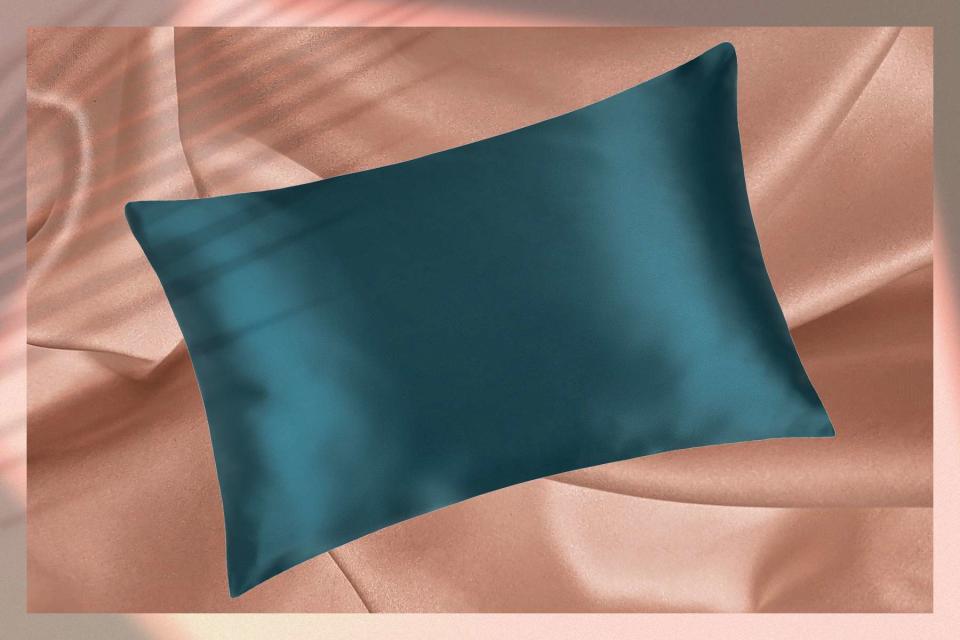Silk vs. Satin Pillowcase: Which One Is Better for Your Hair?
Both make sleeping a luxurious experience.

The right deep conditioner, mask, and co-wash are important for maintaining natural hair, but just like wrapping your curls in a silk or satin turban or putting on a bonnet before bed, switching to a pillowcase made out of one of these fabrics can also help protect your hair texture.
Both silk and satin pillowcases look high-end and feel like you're sleeping on a luxurious cloud, but which one is better for your hair? Ahead, hair experts Angela Onuoha, Erinn Courtney, and Dr. Isfahan Chambers-Harris break down the difference between silk vs. satin pillowcases, along with how to figure out which one you should sleep on for your curls.
Meet Our Expert
Angela Onuoha is a certified trichologist and Rhyme & Reason ambassador.
Erinn Courtney is a StyleSeat hairstylist and natural haircare professional.
Dr. Isfahan Chambers-Harris, Ph.D., is a trichologist and founder of Alodia Hair Care.
What Is Silk?
Silk is a natural fiber produced by insects to create their cocoons and nests. It was first developed in ancient China, and the silk trade started over 3,000 years ago. The fiber is woven into textiles and used to create a wide range of products, from dresses to pillowcases.
It's known for being luxurious and soft and is hypoallergenic and less absorbent than other fabrics. These attributes are what make silk great for your hair. "We are used to sleeping on cotton pillowcases but cotton is known for its great absorbing power. Since we sleep on it on average eight hours a day it means that in those eight hours it has all the time to absorb all the moisture and oils out of both your hair and your skin," says Onuoha. "Silk doesn't do that. So all the moisture and oils maintain on your skin and hair."
Silk also produces less friction on the hair. "Your hair won't snag and break because the material allows your hair to glide along softly while moving on the pillow," says Courtney.
Related: The 10 Best Silk Pillowcases of 2024, Tested and Reviewed
What Is Satin?
While satin might look like silk, they're not exactly one in the same. While satin used to be made from silk, today, it's often created with a blend of cotton and synthetic fibers like polyester and rayon.
Satin offers similar haircare benefits to silk, but it's more absorbent. "Satin absorbs a little bit more than silk since it's a mixture of numerous materials including cotton, but it's still way less than 100% cotton pillowcases," Onuoha says. "It gives a little bit more friction than silk but again: way less than cotton."
Related: The 8 Best Satin-Lined Fall Hats and Hair Accessories to Avoid Breakage
VIDEO: Dealing With Dry Natural Hair? These Products Are Ready to Flip the Script
Silk vs. Satin Pillowcase
Both types of pillowcases will be gentle on curls, helping to prevent breakage and dryness. Which one you choose comes down to a few factors, like price and preference.
"I like satin more because it's less expensive than silk, but it's also smoother than silk, reducing the friction between the hair strands and the pillowcase," says Dr. Chambers-Harris.
Quality is another factor to consider. "The difference may come in the quality of the pillowcases and how long they're able to last you through washes and everyday wear and tear," Courtney says. Silk will typically last longer because it's higher quality.
If you prefer satin because it better aligns with your budget, it's still a huge upgrade from a cotton pillowcase. And if you're really concerned about the slight loss of moisture, Onuoha suggests giving your curls a quick oil treatment. "Apply a couple of drops of a serum (Rhyme & Reason Argan Oil Smooth Finishing Serum or the Rhyme & Reason Plant Protein Damage Repair Serum) to the ends, then work what is left on hands through the rest of your strands to compensate that loss overnight," she says.
This is All Natural. From the kinkiest coils to loose waves, we're celebrating natural hair in its many forms by sharing expert tips for styling, maintenance, and haircare.
For more InStyle news, make sure to sign up for our newsletter!
Read the original article on InStyle.

